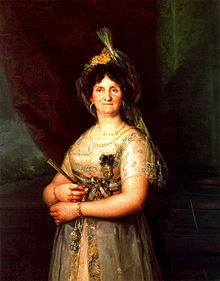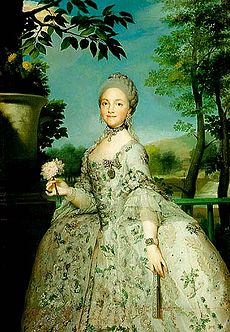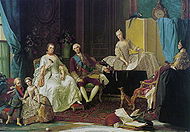- Maria Luisa of Parma
-
Maria Luisa of Parma 
Portrait of Queen Maria Luisa by Vicente López, after an original by Goya (1816). Queen consort of Spain Consort 1788–1808 Spouse Charles IV Issue Carlota, Queen of Portugal
Maria Luisa, Queen of Etruria
Ferdinand VII
Carlos, Count of Molina
Maria Isabella, Queen of the Two Sicilies
Infante Francisco de PaulaHouse House of Bourbon Father Philip, Duke of Parma Mother Princess Louise Élisabeth of France Born 9 December 1751
Parma, ItalyDied 2 January 1819 (aged 67)
Barberini Palace, Rome, ItalyBurial El Escorial Religion Roman Catholicism Maria Luisa of Parma (9 December 1751 – 2 January 1819) was Queen consort of Spain from 1788 to 1808 as the wife of King Charles IV of Spain. She was the youngest daughter of Duke Philip of Parma and his wife, Louise-Élisabeth of France, the eldest daughter of King Louis XV.
She was christened Luisa Maria Teresa Ana, but was known as María Luisa.[1] She, her brother, the next Duke, Ferdinand, Duke of Parma and her sister Princess Isabella of Parma, Archduchess of Austria, deceased at the age of 22, were educated there by Étienne Bonnot de Condillac, (Grenoble, 1715 - Parma, 1780), well known French philosopher and member of the French Academy since 1768, a friend of Denis Diderot and Jean Jacques Rousseau. Her French teacher's works, including many of the texts, some 13, he wrote to educate the three Ducal pupils, were edited in 23 volumes in 1798 being reprinted some 3 times before 1822.
Further, Parma Duchy marriage connections with the Austrian Emperor's family for her brother Ferdinand, later Duke Ferdinand, and sister Isabella, and improvements in wealth and industry with their father, Duke Philip, had been ensured by the Parma Prime Minister, Léon Guillaume du Tillot, (Bayonne, 1711 - Paris, 1774), exiled from France as too liberal by King Louis XV of France.
Contents
Biography
Maria Luisa of Parma was born in Parma, Italy. Her parents had been the Duke and Duchess of Parma since 1749 when the Treaty of Aix-la-Chapelle (1748) gave the Bourbons the Duchy; Austria had previously owned the Duchy. She was the favourite child of her mother, who tried to engage her to the Duke of Bourgogne, heir to the French throne. However, the young Duke died in 1761, so in 1762 Maria Luisa became engaged to the Prince of Asturias (heir to the throne), Charles, later King Charles IV of Spain, whom she married on 4 September 1765 in La Granja Palace.
As there was no Queen in Spain at that time, Maria Luisa became the first lady of the court from the beginning. Her husband was the son and heir of the widowed Charles III of Spain, previously Duke of Parma and King of Naples and Sicily. His wife, Maria Amalia of Saxony (aunt of the Duke of Burgundy) had died in 1760 having been Queen of Spain for just a year.
 Portrait of Maria Luisa as Princess of Asturias, in the gardens of Aranjuez (ca. 1766), by Anton Raphael Mengs.
Portrait of Maria Luisa as Princess of Asturias, in the gardens of Aranjuez (ca. 1766), by Anton Raphael Mengs.
The famous Spanish artist Goya painted several of her portraits. She was often described by contemporaries as an ugly (however, pretty in her youth), vicious, and coarse woman who thoroughly dominated the king. She had well-known rivalries with the Duchess of Alba, the Duchess of Osuna and her sister-in-law, Maria Carolina, Queen of Naples. Her beauty was damaged by her many childbirths - among other things, she lost her teeth - but she made many efforts to look pretty and dress elegantly; she had beautiful arms and she often wore short-sleeved dresses to expose them.
Maria Luisa dominated her husband and was believed to have had many love affairs, but there is no evidence that Maria Luisa had any lovers. Gossip pointed out Manuel de Godoy, her husband's Prime Minister, was her long-time lover. She was unpopular during her reign and has also long had a bad reputation in history, mainly because of her alleged love affairs and her support of pro-French policies that eventually weren't good for Spain. In 1792, the Order of Queen Maria Luisa was founded on her suggestion, an order which was given only to women.
Maria Luisa didn't get along with her daughter-in-law Princess Maria Antonia of Naples and Sicily, because the princess tried to undermine her power, guided by her mother, Maria Carolina. After several miscarriages, Maria Antonia died from tuberculosis, an illness she had suffered for several years. According to the memoirs of the Duchess of Abrantes, it was rumored that she was poisoned by Maria Luisa, although there is actually no evidence that Maria Antonia was poisoned.
Due to pressure from Napoleon, her husband abdicated the throne of Spain in 1808, and together with Maria Luisa and Godoy spent the rest of his life in exile. When Napoleon's army invaded the country, several pamphlets blamed her for that. Maria Luisa spent some years in France and then in Rome, Italy. Both Maria Luisa and her husband died in Italy in early 1819.
Issue
Maria Luisa's 14 children were:
- Carlos Clemente (19 September 1771 – 7 March 1774)
- Carlota Joaquina (Carlota Joaquina) (25 April 1775 – 7 January 1830), later Queen consort of Portugal
- Maria Luisa (11 September 1777 – 2 July 1782)
- Maria Amalia (9 January 1779 – 22 July 1798), married in 1795 to her uncle Infante Antonio Pascual of Spain (1755–1817), no issue
- Carlos Domingo (5 March 1780 – 11 June 1783)
- Maria Luisa (6 July 1782 – 13 March 1824), later Queen consort of Etruria and Dowager Duchess of Parma
- Carlos Francisco (5 September 1783 – 11 November 1784)
- Felipe Francisco (5 September 1783 – 18 October 1784)
- Ferdinand VII of Spain (14 October 1784 – 29 September 1833), succeeded his father as King of Spain
- Carlos, Count of Molina (29 March 1788 – 10 March 1855), later the first Carlist pretender. Issue: 3 males reached adulthood.
- Maria Isabella (6 June 1789 – 13 September 1848), later Queen consort of Francis I, King of the Two Sicilies
- Maria Teresa (16 February 1791 – 2 November 1794)
- Felipe Maria (28 March 1792 – 1 March 1794)
- Francisco Antonio de Paula, Duke of Cadiz (10 March 1794 – 13 August 1865). He married his niece, Princess Luisa Carlotta of Naples and Sicily, fathering no fewer than 11 children.
Gallery
-
Maria Luisa of Parma (1765), by Anton Raphael Mengs, Prado Museum, Madrid.
-
Maria Luisa of Parma in court dress (1789), by Goya, Prado Museum, Madrid.
-
The Queen's Coat of arms[2]
Ancestry
Ancestors of Maria Luisa of Parma 16. Louis XIV of France 8. Louis, Dauphin of France 17. Maria Theresa of Spain 4. Philip V of Spain 18. Ferdinand Maria, Elector of Bavaria 9. Maria Anna of Bavaria 19. Princess Henriette Adelaide of Savoy 2. Philip, Duke of Parma 20. Ranuccio II, Duke of Parma 10. Odoardo Farnese 21. Isabella of Modena 5. Elisabeth Farnese 22. Philipp Wilhelm, Elector Palatine 11. Dorothea Sophie of Palatine-Neuburg 23. Elisabeth Amalie of Hesse-Darmstadt 1. Maria Luisa of Parma 24. Louis, Dauphin of France (=8) 12. Louis, Dauphin of France (1682-1712) 25. Duchess Maria Anna of Bavaria (=9) 6. Louis XV of France 26. Victor Amadeus II of Sardinia 13. Princess Marie-Adélaïde of Savoy 27. Anne Marie d'Orléans 3. Princess Louise Élisabeth of France 28. Rafał Leszczyński 14. Stanisław Leszczyński 29. Anna Jabłonowska 7. Maria Leszczyńska 30. Jan Karol Opaliński 15. Katarzyna Opalińska 31. Zofia Czarnkowska Notes
- ^ E. Harding, A Chronological Abridgement of the History of Spain (Frogmore Lodge, Windsor, 1809), xxxi
- ^ Queen Arms description. Encuadernación Real Biblioteca. Royal Library. Royal Palace of Madrid (In Spanish).
Bibliography
- EPTON, Nina, The Spanish mousetrap: Napoleon and the Court of Spain (London: Macdonald, 1973).
- GONZÁLEZ-DORIA, Fernando, Las reinas de España (Madrid: Trigo, 2003).
- HILT, Douglas, The troubled trinity: Godoy and the Spanish monarchs (Tuscaloosa; London: University of Alabama Press, 1987).
- HUGUES, Robert, Goya (London: Harvill Press, 2003).
Titles, styles, honours and arms
Titles and styles
- 9 December 1751 - 4 September 1765 Her Royal Highness Princess Maria Luisa of Parma, Infanta of Spain
- 4 September 1765 - 14 December 1788 Her Royal Highness the Princess of Asturias
- 14 December 1788 - 19 March 1808 Her Majesty the Queen of Spain
- 19 March 1808 - 2 January 1819 Her Majesty Queen Maria Luisa
See also
Maria Luisa of ParmaCadet branch of the House of BourbonBorn: 9 December 1751 Died: 2 January 1819Spanish royalty Preceded by
Maria Amalia of SaxonyQueen Consort of Spain
1788–1808Succeeded by
Julie Clary5th Generation Maria Maddalena · Catherina6th Generation 7th Generation Elisabeth, Queen of Spain8th Generation none9th Generation Isabella, Archduchess of Austria · Maria Luisa, Queen of Spain10th Generation Carolina, Princess Maximilian of Saxony · Princess Maria Antonia · Princess Carlota · Princess Louise11th Generation 12th Generation Princess Luisa13th Generation Margherita, Duchess of Madrid · Alice, Grand Duchess of Tuscany14th Generation Marie Louise, Princess of Bulgaria · Princess Luisa Maria · Princess Maria Inmacolata · Princess Maria Teresa · Princess Maria Pia · Beatrice, Countess Pietro Luchesi Palli · Princess Maria delle Neve · Princess Francesca · Zita, Empress of Austria · Princess Maria Antonia · Princess Isabella · Princess Henrietta15th Generation Princess Elisabetta · Princess Maria Francesca · Princess Giovanna · Alicia, Duchess of Calabria · Princess Maria Cristina · Isabelle, Countess Roger of la Rochefocauld · Maria Francisca, Princess Edwuard of Lobkowicz · Princess Maria Teresa · Princess Cecilia · Princess Maria de las Nieves · Anne, Queen of Romania · Princess Chantal, Mrs. François de Georges · Diane, Princess Franz of Hohenzollern · Princess Elisabeth, Duchess of Hohenberg*^ · Marie-Adélaïde, Countess of Donnersmarck*^ · Marie Gabriele, Countess of Holstein-Ledreborg*^ · Alix, Princess of Ligne*^16th Generation Margarita, Countess of Colorno · Carolina, Marchioness of Sala · Princess Lorraine · Princess Inés · Princess Sybilla, Mrs. Craig Richards · Princess Victoire, Mrs. Carlos Rodríguez · Archduchess Marie-Astrid of Austria*^ · Princess Margaretha of Liechtenstein*^17th Generation Princess Antoinette · Princess Marie Gabrielle · Princess Alexia · Pricess Charlotte · Princess Elisabeth · Princess Zita*also princess of Luxembourg by marriage
^also princess of Nassau by marriageInfantas of Spain by marriage 1st generation 2nd generation none3rd generation 4th generation none5th generation none6th generation none7th generation Louise Élisabeth d'Orléans · Infanta Barbara of Portugal · Princess Maria Amalia of Saxony · Princess Louise Élisabeth of France8th generation Princess Maria Luisa of Parma · Infanta Mariana Victoria of Portugal · Infanta Maria Amalia of Spain* · Archduchess Maria Amalia of Austria9th generation Princess Maria Antonia of Naples and Sicily · Infanta Maria Francisca of Portugal · Infanta Teresa of Portugal, Princess of Beira · Princess Luisa Carlotta of Naples and Sicily10th generation Princess Maria Carolina of the Two Sicilies · Archduchess Maria Beatrix of Austria-Este · Isabella II of Spain* · Infanta Maria Cristina of Spain* · Princess Maria Amalia of the Two Sicilies · Princess Maria Teresa of Savoy11th generation Infanta Eulalia of Spain* · Princess Margherita of Parma · Princess Louise Marie Thérèse of France · Berthe de Rohan · Infanta Maria das Neves of Portugal12th generation Princess Louise of Orléans · Princess Beatrice of Saxe-Coburg and Gotha · Princess Maria Pia of Bourbon-Two Sicilies · Infanta Maria Antonia of Portugal13th generation Princess Mercedes of the Two Sicilies · Princess Alicia of Parma14th generation 15th generation *also an Infanta in her own right
**did not have a royal or noble title by birth but was admitted as InfantaPrincesses of Asturias Letizia Ortiz Rocasolano (2004-present)
Princess Maria Antonia of Naples and Sicily (1802-1806) · Princess Maria Luisa of Parma (1765-1788) · Infanta Barbara of Portugal (1729-1746) · Louise Élisabeth d'Orléans (1722-1724) · Princess Elisabeth of France (1615-1621) · Mary I of England (1554-1556) · Infanta Maria Manuela of Portugal (1543-1545) · Archduchess Margaret of Austria (1497) · Blanche II of Navarre (1468-1474) · Catherine of Lancaster (1388-1406)Categories:- Spanish royal consorts
- Princesses of Asturias
- House of Bourbon-Parma
- Dames of the Order of Queen Maria Luisa
- Princesses of Bourbon-Parma
- House of Bourbon (Spain)
- Smallpox survivors
- 1751 births
- People from Parma
- 1819 deaths
- Burials in the Pantheon of Kings at El Escorial
Wikimedia Foundation. 2010.






